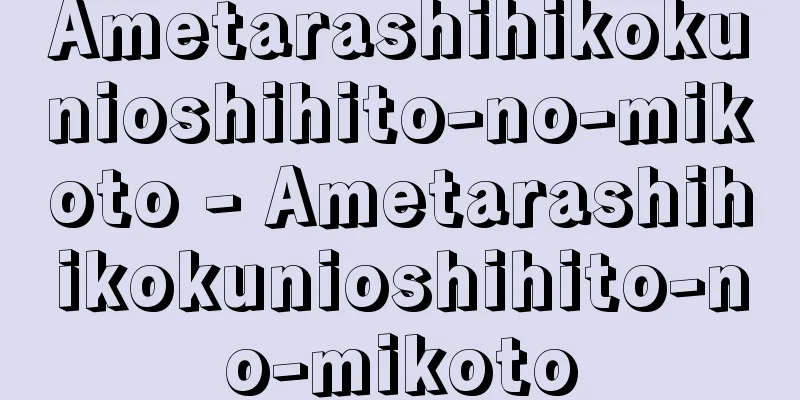Car phone - jidousha denwa

|
A type of mobile communication. It is a telephone system that connects telephones installed in automobiles to base stations (radio circuit control stations) via radio waves, and connects base stations, automobile telephone exchanges, and telephone offices with wired lines, allowing automatic dialing to regular subscriber telephones. It also allows calls from the opposite direction and mutual communication with car phones in other automobiles while moving. It was used in common with mobile phones until 2000, and was treated as a mobile/car radio phone. [Iwao Ishijima] HistoryIn Japan, there have been "mobile police radio telephones," "mobile firefighting radio telephones," and "disaster prevention administrative radio telephones" for some time. Although these were important mobile car radio telephone services, they were simply duplex radio telephones connected to a wired communication network, and were different in form from the car telephones described below. The car radio telephone is called the NTT system, and was developed by the Nippon Telegraph and Telephone Public Corporation, and was completed in 1967 (Showa 42) as a fully automatic switching system for civilian car telephones. However, the 400 MHz band that was initially allowed was a narrow band for car telephones, and there were not enough channels to accommodate the number of people who wanted to join, so it began operating as a city disaster response radio telephone in 1974. After that, the 800 MHz band was released in 1979, and the era of full-scale car telephones began, but since the equipment was rented from the public corporation, and the security deposit, monthly basic fee, and call charges were expensive, it was only installed in the private cars of company executives. The communication method that was initially adopted was an analog cellular system. Cellular means "cell-like". In the cellular system, a small zone (cell) with a diameter of 3 to several kilometers is set as one communication area around a base station, and these are placed in necessary areas such as urban areas and along highways, and gradually expand to form a larger communication area. This system automatically controls the location registration of passing cars, the selection of available channels, and channel changes due to zone changes, so the coordination of information exchange between base stations is complex and the capital investment for base stations is large. However, it has the advantage of being efficient in using frequencies, which are a limited resource, and so this system was adopted in Japan. In that year (1979), Nippon Telegraph and Telephone Public Corporation started service in the Tokyo area (23 wards) using an analog system. The communication method at that time was Frequency Division Multiple Access (FDMA) and the modulation method was Frequency Modulation (FM). Base stations were allocated the 843-846 MHz and 860-885 MHz frequency bands, while land mobile stations (vehicle side) were allocated the 898-901 MHz and 915-940 MHz frequency bands. It was stipulated that the transmission frequency of mobile stations would automatically be selected from within the frequency band allocated to the mobile station, which would be 55 MHz higher than the radio waves transmitted from the base station (Article 49-6 of the Radio Equipment Regulations). Then, in 1985, the so-called Telecommunications Reform Act came into force, and Nippon Telegraph and Telephone Public Corporation was privatized to become Nippon Telegraph and Telephone Corporation (NTT). At the same time, the Telecommunications Business Act came into force, and regulations on telecommunications businesses were greatly relaxed, allowing new businesses to enter the market. In the 1980s, car phones were powered by the car battery, and were the size you would imagine from the name "shoulder phone." This was too small for a person to carry around, so it was a luxurious system that had to rely on the transport capacity of the car. However, in the 1990s, the surrounding technology improved, ICs (integrated circuits) were developed, and small lithium batteries were developed, so mobile phones became small enough to be carried in a pocket. In 1991, regulations were added to reform to the time division multiple access (TDMA) system, and preparations for digitalization were completed. Based on this, from April 1994, mobile and automobile radio telephones were converted to the digital system, and with the introduction of a system of selling telephones, prices fell and they quickly became popular. In July 1992, NTT's mobile communications division was separated and NTT Mobile Communications Network Co., Ltd. (now NTT DoCoMo) began operations. In 1999, the International Telecommunication Union (ITU) recommended a standard called IMT-2000 (International Mobile Telecommunication 2000). This standard allowed the use of the 2000 MHz frequency band, and meant that by the year 2000, data transmission speeds of 2000 kilobits per second (kbps) would be achieved when stationary. The use of the 2000 MHz band led to smaller devices, and the antenna was housed inside the handset itself. The connection method became code division multiple access (CDMA), which increased the number of connections and stabilized them. As a result, ordinary mobile phones had the performance to be used on high-speed moving objects, and it was no longer necessary to call them mobile or car phones, so on March 1, 2000, the Ministry of Internal Affairs and Communications changed mobile and car radio telephone communications to simply mobile radio communications (amendment to Article 49-6-2 of the Radio Equipment Regulations). This communication system therefore left the automobile at this point and developed into its own mobile phone. It is a communication system that seems to fulfill the human desire to be able to communicate with anyone, anywhere, anytime, and there is a trend for it to continue to develop, but it is also a fragile system that cannot communicate where there are no cells. This does not mean that we can abolish the conventional wired telephone system, but it is important to fully understand that these are communication systems that are mutually dependent on each other and to continue to develop them. [Iwao Ishijima] [References] | |Source: Shogakukan Encyclopedia Nipponica About Encyclopedia Nipponica Information | Legend |
|
移動体通信の一つ。自動車に取り付けた電話機と基地局(無線回線制御局)との間を電波で結び、基地局、自動車電話交換局、電話局を有線回線で接続し、一般加入電話とダイヤル自動接続ができる電話システムである。逆方向からの呼出しや走行中の他の自動車の自動車電話との相互通信も可能である。2000年(平成12)まで携帯電話と共用され、携帯・自動車無線電話として扱われた。 [石島 巖] 沿革日本では以前から「移動警察無線電話」「移動消防無線電話」「防災行政無線電話」が存在した。これらは、重要な自動車移動無線電話業務通信ではあったが、単に複信式の無線電話機を有線通信網に接続しただけのもので、以下に述べる自動車電話とは形態を異にする。自動車無線電話とはNTT方式とよばれるもので、日本電信電話公社によって開発され、1967年(昭和42)には全自動交換方式の民間用自動車電話として完成した。しかし当初認められた400メガヘルツ(MHz)帯は自動車電話にあてる帯域が狭く、加入希望者に十分対応できるチャネルが得られないために、都市災害対策用無線電話として1974年から運用を開始した。その後、1979年に800メガヘルツ帯が解放されて、本格的な自動車電話の時代となるが、機器が公社からのレンタルであり、保証金、月額基本料、通話料などが高価であるため、会社重役の専用車などに取り付けられるにすぎなかった。その通信方式としては最初に、アナログ方式によるセルラー方式が採用された。セルラー(cellular)とは「細胞状の」という意味。セルラー方式は一つの基地局を中心とする直径3~数キロメートルの小ゾーン(cell)を一つの通信圏とし、これを市街地や高速道路沿線など必要な地域に適宜に配置し、しだいに拡大して大きな通信圏を形成する。このシステムは通過する自動車の通話に関する位置登録、空チャネルの選択、ゾーンの変更によるチャネル変更などの制御を自動的に行うので、基地局間の情報交換の連携は複雑であり、基地局に対する設備投資は大きくなる。しかし、有限の資源である周波数の利用効率がよいという利点があって、日本としてはこの方式が採用された。この年(1979)に日本電信電話公社が東京地区(23区)においてアナログ方式でサービスを開始している。そのときの通信方式は周波数分割多元接続(FDMA)方式であり、変調方式は周波数変調(FM)であった。使用周波数として、基地局に843~846メガヘルツと860~885メガヘルツ、陸上移動局(自動車側)には898~901メガヘルツと915~940メガヘルツの周波数帯が割り当てられ、移動局の送信周波数は、移動局に割り当てられた周波数帯のなかで、基地局から送信された電波より55メガヘルツ高い周波数が自動的に選択されるように規定された(無線設備規則49条の6)。 その後、1985年にいわゆる電電改革三法が施行され、日本電信電話公社が民営化されて日本電信電話株式会社(NTT)となるとともに、電気通信事業法の施行に伴い、電気通信事業者への規制が大幅に緩和され新規事業者が参入した。1980年代では自動車電話は電源を自動車のバッテリーから得ていたし、大きさもショルダーホンという名前で想像できるサイズの装置であった。これは人間が持ち歩けるサイズではないので、自動車の運搬能力に期待せざるを得ない、いわばぜいたくなシステムであった。 これが1990年代に入ると周辺の技術が進歩し、IC(集積回路)化も進み、小型のリチウム電池なども開発されたので、携帯電話もポケットに入れて持ち運びできるほどに小型化した。1991年には時分割多元接続(TDMA)方式に改革する規定が追加され、デジタル化への準備が完成。これに基づき、1994年4月から、携帯・自動車無線電話はデジタル方式に改められ、電話機の売切制度の導入に伴い低価格化され急速に普及した。なお、1992年(平成4)7月には、NTTの移動体通信部門を分離したNTT移動通信網株式会社(現在のNTTドコモ)が営業を開始した。 1999年、国際電気通信連合(ITU)はIMT-2000(International Mobile Telecommunication 2000)という規格を勧告した。この規格は周波数に2000メガヘルツ帯の使用を認め、2000年までに、静止時に2000キロビット毎秒(kbps)のデータ伝送速度を実現するという意味合いのものであった。2000メガヘルツ帯の使用により小型化が進み、アンテナも無線電話器本体の中に収容された。接続方式は符号分割多元接続(CDMA)になり接続数の増加と安定化が実現することになった。この結果、普通の携帯電話が高速の移動体で使用しうる性能をもつに至り、携帯・自動車電話と呼称する必要が認められなくなったので、総務省は2000年3月1日、携帯・自動車無線電話通信を、単なる携帯無線通信に改めた(無線設備規則49条の6の2の改正)。このため、この通信システムはこの時点から自動車を離れ独自に携帯電話へと発展してゆくことになったのである。「いつでも、どこでも、だれとでも」という人間の欲望が達成されたとも思える通信システムで、さらに発展する趨勢(すうせい)にあるが、セル(cell)のない所では通信できない脆弱(ぜいじゃく)なシステムでもある。これがあれば、在来の有線電話システムを廃止してよいというものではなく、相互に依存関係にある通信システムであることをよく理解して発展させてゆくことがたいせつである。 [石島 巖] [参照項目] | |出典 小学館 日本大百科全書(ニッポニカ)日本大百科全書(ニッポニカ)について 情報 | 凡例 |
<<: Car registration - jidousha toroku
>>: Automobile Liability Compensation Security Law - jidoushasongaibaishoshoho
Recommend
Ophioplocus japonicus (English spelling) Ophioplocusjaponicus
…Most species are free-living, but many species l...
Dormitory - gakuryo
〘noun〙① During the Heian period, a boarding house ...
Downstream water intake - Karyushusui
…There are two ways to achieve this. One is to se...
Official management - Kansho
〘Noun〙① A subordinate of the Daijokan who performs...
Edictum Perpetuum
A compilation of the proclamations of the praetors...
Utamaro
⇒ Kitagawa Utamaro Kitagawa Utamaro Source: About ...
Piperidine
Hexahydropyridine. C 5 H 11 N (85.15). Also calle...
Soda ash - Soda High
The industrial chemical name of anhydrous sodium ...
Kayes - Kayes (English spelling)
A city in southwestern Mali, West Africa. It is l...
Schottky diode
A diode that utilizes the rectification effect th...
Unstead, JF (English spelling) UnsteadJF
...Later, W. Köppen improved on this system, plac...
Gyokuro - Gyokuro
This is the highest quality Japanese green tea. I...
Hidaka Tokichirō
1857‐1937 (Ansei 4‐Showa 12) Founder of the Japan ...
Toyo Yamawaki
Year of death: August 8, 1762 (September 25, 1762)...
The Eika Rebellion
A rebellion that occurred in China during the Yon...


![Krakatoa [island] - Krakatoa](/upload/images/67cb6d30e960f.webp)






